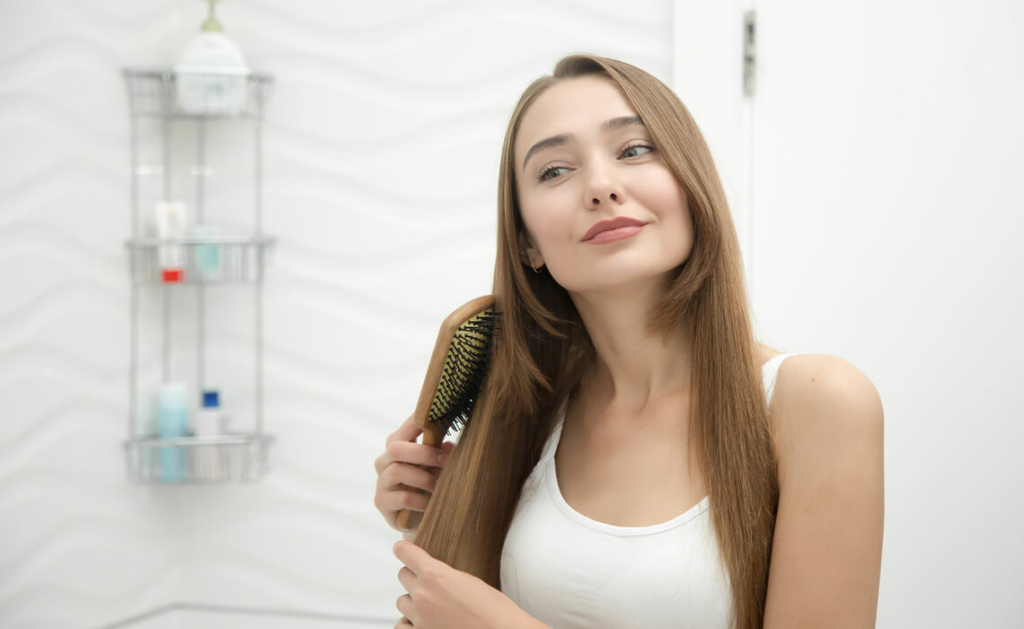Having a haircare routine tailored to your specific hair type is the key to achieving healthy, beautiful locks. Whether your hair is straight, curly, wavy, fine, thick, or somewhere in between, understanding your unique needs and selecting the right products and practices will help you maintain and enhance your hair’s natural beauty. Here’s how to create a customized haircare routine for your hair type:

Identifying Your Hair Type
Before you can create a customized haircare routine, it’s crucial to identify your hair type. Here are some common hair types and their characteristics:
- Straight Hair: Straight hair lacks natural curls or waves and is often smooth and sleek.
- Wavy Hair: Wavy hair features loose curls or waves, creating a relaxed and tousled appearance.
- Curly Hair: Curly hair forms tight or loose curls, ranging from soft waves to well-defined coils.
- Coily/Kinky Hair: Coily or kinky hair has tightly coiled, spring-like curls, appearing dense and voluminous.
- Fine Hair: Fine hair has a smaller hair strand diameter and may lack volume.
- Medium/Normal Hair: Medium or normal hair falls between fine and coarse hair and typically has a balanced texture and thickness.
- Thick/Coarse Hair: Thick or coarse hair has a larger hair strand diameter, often feels heavy, and may be more prone to frizz.
- Dry or Damaged Hair: Dry or damaged hair lacks moisture and can be brittle, frizzy, or prone to split ends.
Creating Your Customized Haircare Routine
Once you’ve identified your hair type, you can tailor your haircare routine to address its specific needs:
1. Shampoo and Conditioning:
- Select the Right Shampoo: Choose a shampoo designed for your hair type. For example, use a volumizing shampoo for fine hair, a hydrating or curl-enhancing shampoo for curly hair, or a sulfate-free shampoo for coily/kinky hair.
- Use Conditioner Wisely: Apply conditioner primarily to the mid-lengths and ends of your hair, avoiding the roots if your hair tends to get oily. Use a conditioner formulated for your specific needs, such as a volumizing conditioner for fine hair or a deep-conditioning conditioner for damaged hair.
2. Frequency of Washing:
- Straight and Fine Hair: These hair types may require more frequent washing, as they tend to get oily quickly.
- Curly, Coily/Kinky, and Thick Hair: These hair types can often go longer between washes to retain natural oils and moisture.
3. Heat Styling:
- Use Heat Protectant: Apply a heat protectant spray before using hot styling tools to shield your hair from damage.
- Adjust Heat Settings: Lower heat settings are often sufficient for fine hair, while thicker hair may require higher temperatures. Be mindful of not overheating your hair.
4. Styling Products:
- Select the Right Products: Choose styling products that suit your hair type, whether it’s a frizz control serum for curly hair or a lightweight volumizing mousse for fine hair.
- Avoid Overloading: Don’t overuse styling products, as this can weigh down your hair. Start with a small amount and adjust as needed.
5. Hair Treatments:
- Weekly Deep Conditioning: Consider incorporating a weekly deep-conditioning treatment or hair mask to nourish and repair your hair.
- Monthly Scalp Treatments: If you have a dry or flaky scalp, use a monthly scalp treatment to maintain scalp health.
6. Regular Trims:
- Trim Your Ends: Schedule regular trims every 6-8 weeks to remove split ends and keep your hair looking healthy.
7. Nighttime Care:
- Use Silk Pillowcases: Silk pillowcases reduce friction and prevent hair breakage while you sleep.
8. Dietary Considerations:
- Stay Hydrated: Proper hydration is essential for healthy hair. Drink enough water daily.
- Balanced Diet: Consume a balanced diet rich in vitamins and minerals, especially biotin and keratin, which promote hair health.
By creating a customized haircare routine tailored to your hair type, you’ll be well on your way to achieving and maintaining hair that’s healthy, beautiful, and full of vitality. Remember that consistency is key, and be open to adjusting your routine based on your hair’s changing needs throughout the seasons and over time.



